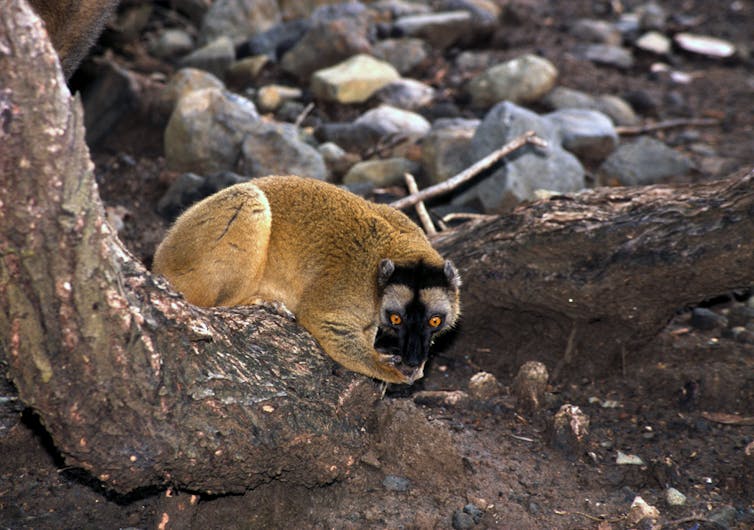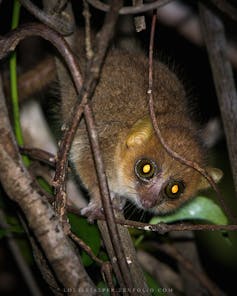Muddy, mosquito-ridden mangrove swamps are difficult places to live. Few species of plants or invertebrates bother. As a result there aren’t many specialist mangrove-dwellers among the world’s mammals, and these forests, highly threatened halfway houses between land and sea, tend to be neglected by wildlife conservationists.
But what about non-specialist animals? Do species more typically found in regular forests also use mangroves if the opportunity arises? Surprisingly, that’s a question we have very few answers to, but one I set out to investigate for one of the most charismatic and threatened of all animal groups: Madagascar’s lemurs. And I was amazed by what I found.
I have long been fascinated by both mangroves and lemurs, but these two interests collided one magical evening in March 2015. My wife and I were carrying out a bird survey at Antsahampano, deep in the mangroves of north-west Madagascar, for the marine conservation organisation Blue Ventures. We camped the night on a small sandy island offshore and, as we always do, went for a night walk after dinner to see what we could find.

We certainly weren’t expecting any lemurs – after all, we were about 3km from the nearest dry land, with nothing but mangroves in between – and we saw little but crabs for most of the way. But just as the rain started falling and we turned back for camp, we spotted the characteristic glimmer of a mammal’s eyes high in a tree, reflected in our torchlight. A fruit bat, I assumed, but as we got closer it turned out to be a northern giant mouse lemur, an endangered species with the wonderful scientific name Mirza zaza, found only in this part of Madagascar.
We were astonished. A lemur? All the way out here in the mangrove? I had already searched the existing literature and knew that only four lemur species had ever been reported in mangroves before, so this sighting really pricked my interest. It occurred to me that perhaps others had seen lemurs in mangroves too but their observations might never have made it into the scientific literature. And so I decided to crowd source.
I put together a database of people who might possibly have ventured into Madagascar’s mangroves – not just primatologists, but hotel owners, guides, and conservationists too. In all I gathered more than 1,200 names, and I emailed them all to ask if they’d ever seen a lemur in a mangrove. Nearly 60 replied, and I published their observations in a recent study in the International Journal of Primatology.
It seems at least 23 species of lemur have been recorded in mangroves, including at least one from each of the five lemur families. If that sounds a lot then bear in mind that, of Madagascar’s 105 lemur species, only 43 of them live in areas that even contain mangroves.
Lemurs seem to use mangroves for a variety of different reasons. Nocturnal species such as Claire’s mouse lemur and Grewcock’s sportive lemur use them to sleep in during the day, while the famous ring-tailed lemur rests in their shade to avoid the midday sun. Some species use mangroves as habitat corridors to move between patches of terrestrial forest, while others seasonally feed on the flowers or fruit of mangrove trees. On the neighbouring island of Mayotte in the Comoros, the introduced brown lemur has even been seen extracting mud from deep inside crab burrows at low tide, presumably to supplement its diet with minerals.

Unfortunately most of the records reported to me were just brief observations, so we still know very little about the importance of mangroves in sustaining lemur populations. One theory is that the animals in mangroves are only there because they are sustained by those in neighbouring forests in a sort of “spill-over” effect. However several of the sightings I reported, such as the northern giant mouse lemur we saw at Antsahampano, were in areas where all the neighbouring forest has been cleared. This suggests mangroves may actually be able to support self-sustaining populations.
So why is this important? Well, lemurs are the most threatened group of mammals on Earth, with as many as 94% of all species at risk of extinction. For example, of the 23 species reported to use mangroves in this study, four count as “critically endangered” on the official Red List, 13 are “endangered” and three are listed as “vulnerable”.
One of the reasons scientists classify these species as threatened is because there is so little forest available to them, but if they are also able to use mangroves then they may not be quite as rare as we thought. The problem is, the mangroves are disappearing too – often just as fast as the neighbouring forests.

Many conservation organisations have turned their attentions towards mangroves in recent years. For example, Blue Ventures is working to give local communities in and around Antsahampano the legal rights to manage their mangroves sustainably, and to develop community-based ecotourism to help generate incentives for conservation.
Such work makes sense: after all, mangroves protect coastlines from erosion, provide feeding grounds and nurseries for commercially important fish and prawns, and store incredible amounts of carbon to help fight climate change.
Yet while these are all excellent reasons to conserve Madagascar’s coastal swamp forests, it’s nice to know that, in doing so, such organisations are also helping to conserve the habitat of some of the world’s cutest critters.

